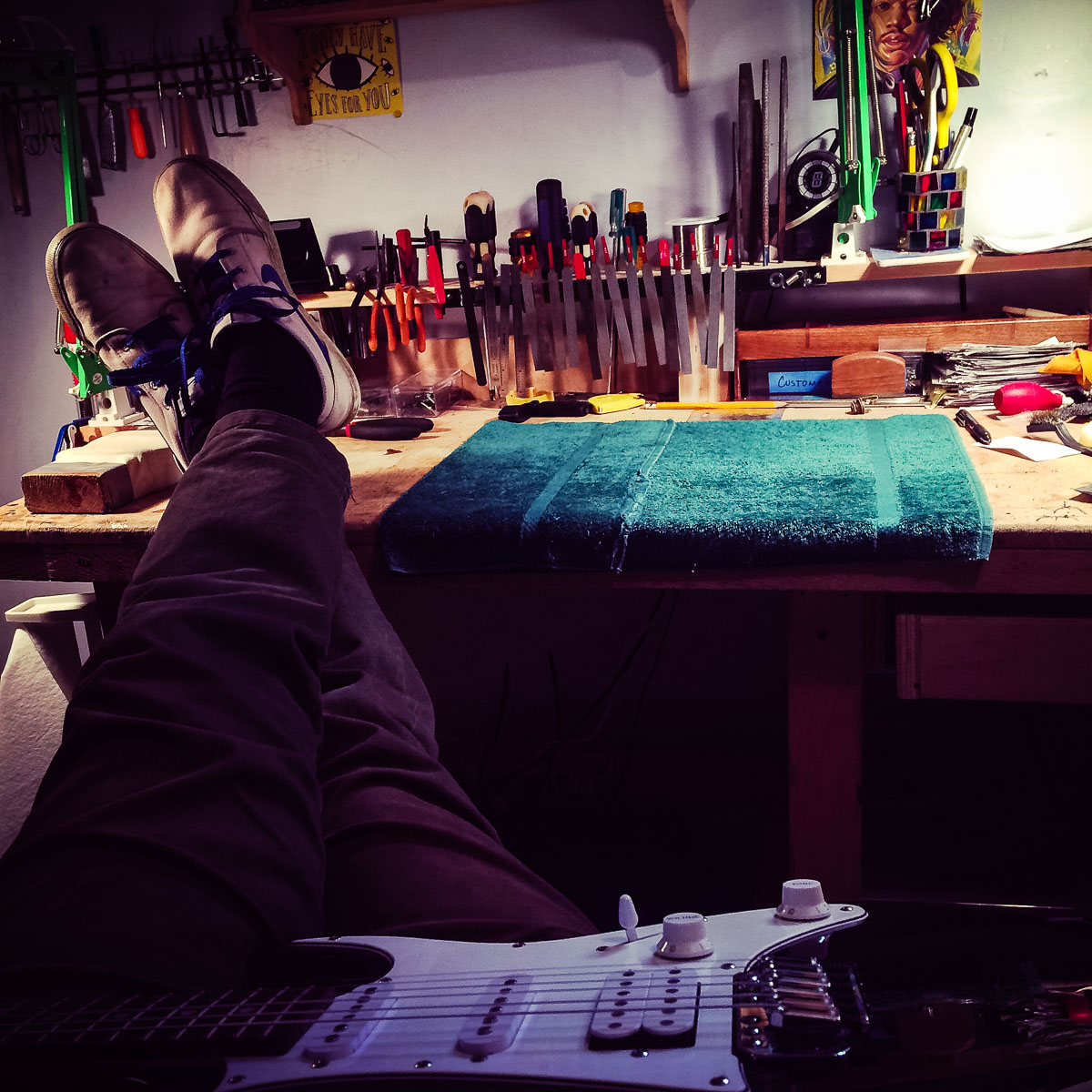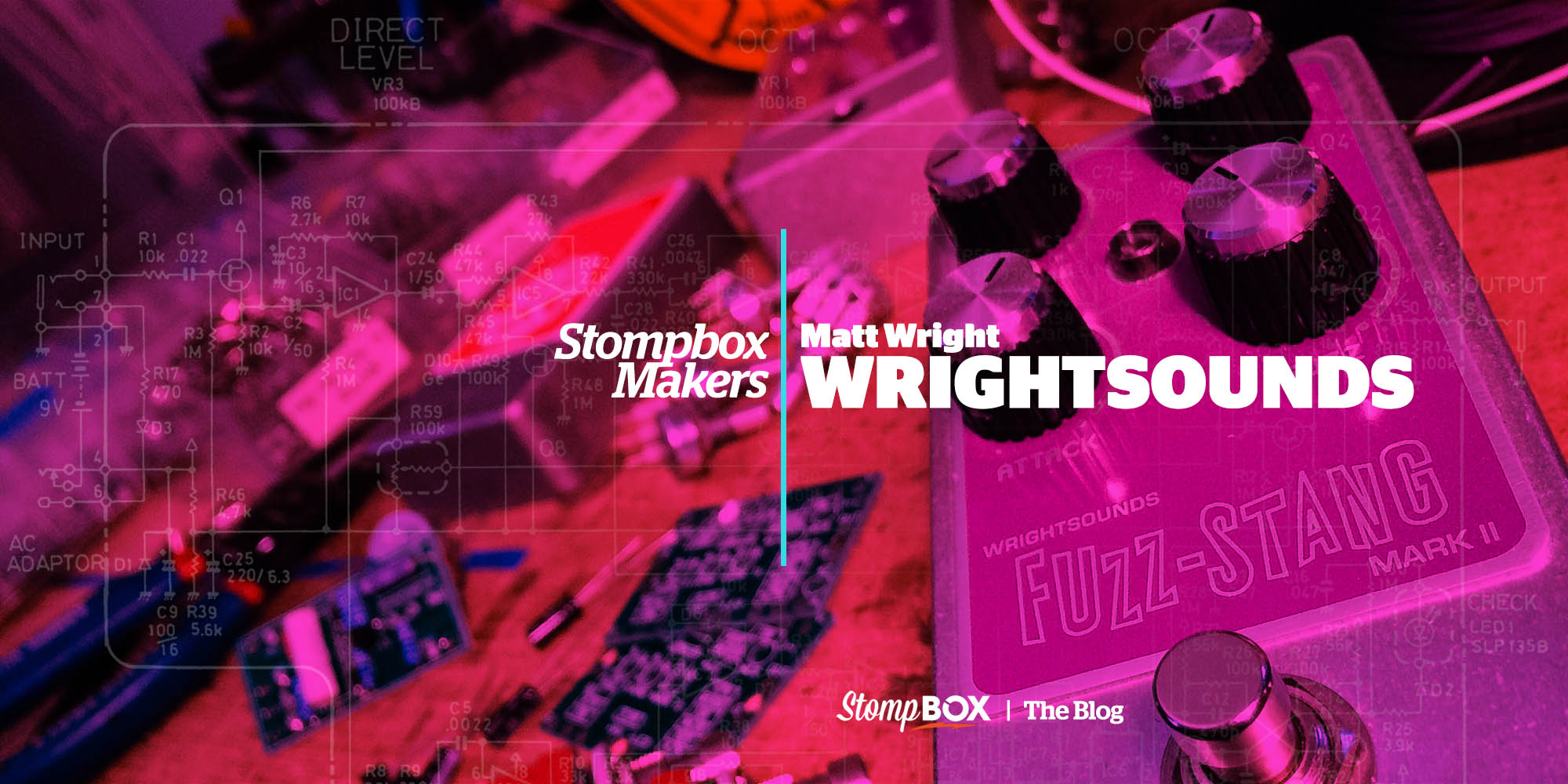Wrightsounds | Stompbox Makers
Matt Wright didn’t choose the fuzz life; the fuzz life chose him.
A professional guitar technician based in Portland, Oregon, Matt built his first Wrightsounds Fuzz-Stang — a clone of the ultra-rare Sam Ash Fuzz-Stainer — on a whim in 2011, never expecting it to become a highly sought-after pedal beloved by such fuzz aficionados as Bill Frisell, Marc Ribot and Lou Reed. But when his original batch of 100 Fuzz-Stangs sold out within a year, Matt was inspired to create the Fuzz-Stang Mark II, an updated version loaded with additional quirks, personality and power.
We asked Matt about his pedal-building journey, and his interactions with some of the Fuzz-Stang’s more famous fans.
How did you get into making pedals?
Well, it was kind of something that I didn’t want to do, honestly. [laughs] I get kind of obsessed with stuff, and the learning curve for being a guitar tech — which is what I primarily am — is pretty steep. So I was still chewing on all of that, and I didn’t want to get into something else. But I got this crazy fuzz pedal, a Sam Ash Fuzz-Stainer, from a client of mine; I was playing through it in a Devo cover band, and after every show, someone would come up and go, “What are you using? It sounds crazy!”
And then the whole cloning thing started, and my clients were telling me, “You should make a clone of that!” I was like, “Yeah, I get it — but I’m doing this guitar tech thing, and I don’t want to get into this pedal world.” So I put it off. I had that pedal for probably two years, and then I moved from New York to Portland, and I had some down time, so I was like, “Well, let’s see what this pedal is all about…” It’s a fuzz pedal, so it was fairly easy to reverse-engineer; it wasn’t like it had a bunch of parts doing crazy things. The only difference was that, in the Sam Ash pedal, the In and Out for the cables were the opposite of where they normally are, so I reversed them [for the Fuzz-Stang]. I ordered some parts online, and the first one I made worked! [laughs]
I didn’t expect for the first proto-type I made to work; I expected to step on the switch and have nothing happen, and just be like, “Okay, cool” and be done with it. But it worked, and it sounded awesome! So I thought, “Okay, I’ll make a hundred — and maybe I’ll sell all of them by the time I die.” I made a little Facebook page for it, and within an hour I was getting messages from places like Germany — it was crazy!
“Hey, Bill Frisell was really digging your pedal!” I was like, “What?!?” He was like, “No, for real. He came to the show last night in Seattle, and he sat in with us for two songs at the end of the show. And afterwards, he was like, ‘Whoa, what’s that?’”
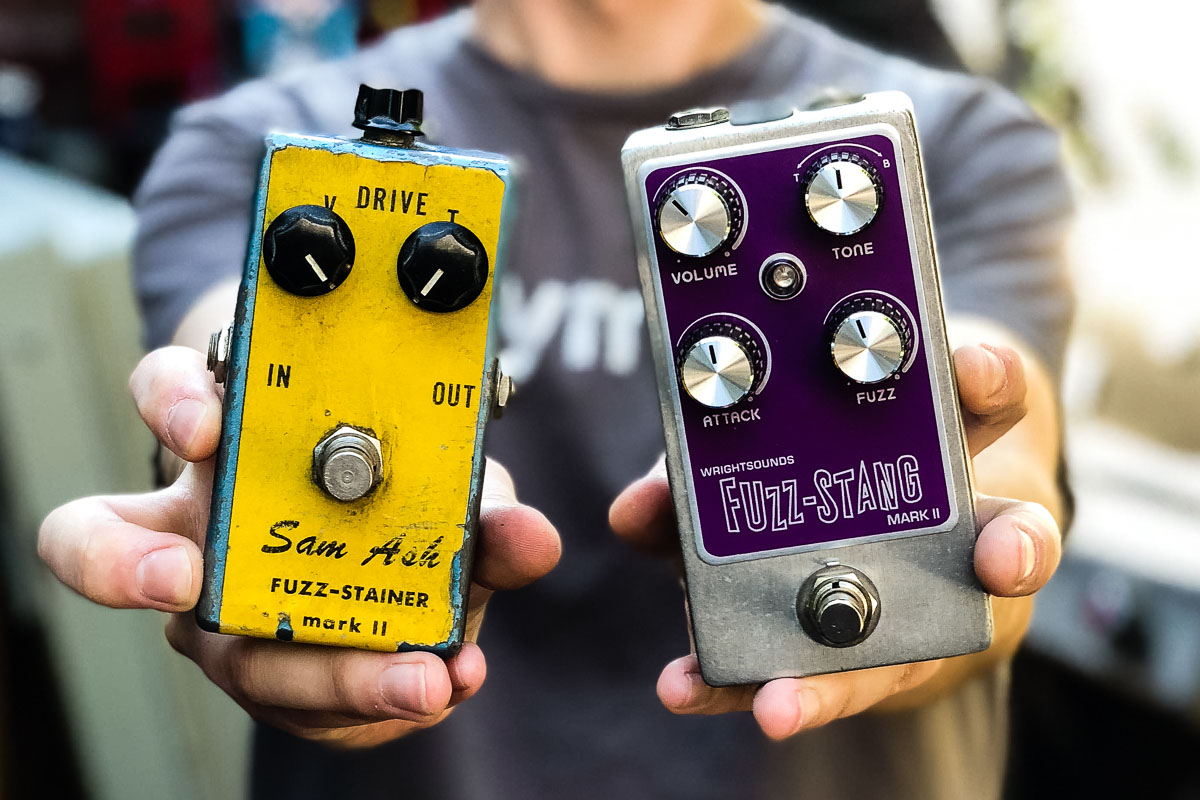 The inspiration, left, Sam Ash Fuzz-stainer, and its offspring, right, Fuzz-stang Mark II. (Photo by John Killtyka)
The inspiration, left, Sam Ash Fuzz-stainer, and its offspring, right, Fuzz-stang Mark II. (Photo by John Killtyka)
How long did it take you to sell out of that initial batch of 100?
I would say within the year. I gave one to a buddy of mine, Timothy Young; he plays guitar with the band on The Late, Late Show with James Corden, but at the time he was in a band in Seattle called Zony Mash. He’s one of my favorite guitarists, and I had seen him since the mid-to-late 90s in the Pacific Northwest. I gave him a Fuzz-Stang; and when he came down to Portland with that band, a couple weeks later, he said, “Hey, Bill Frisell was really digging your pedal!” I was like, “What?!?” He was like, “No, for real. He came to the show last night in Seattle, and he sat in with us for two songs at the end of the show. And afterwards, he was like, ‘Whoa, what’s that?’”
A week later, I get the email: “Bill, meet Matt; Matt, meet Bill.” Bill said he was going to be in Portland, and could he swing by and check this pedal out? Bill came down to my basement and played guitar for like forty-five minutes; and when I tried to give him the pedal, he was like, “No, no!” He paid me full price, what a guy! And then word of mouth just trickled down from there. I think Rich Robinson from the Black Crowes got one. It was pretty awesome.
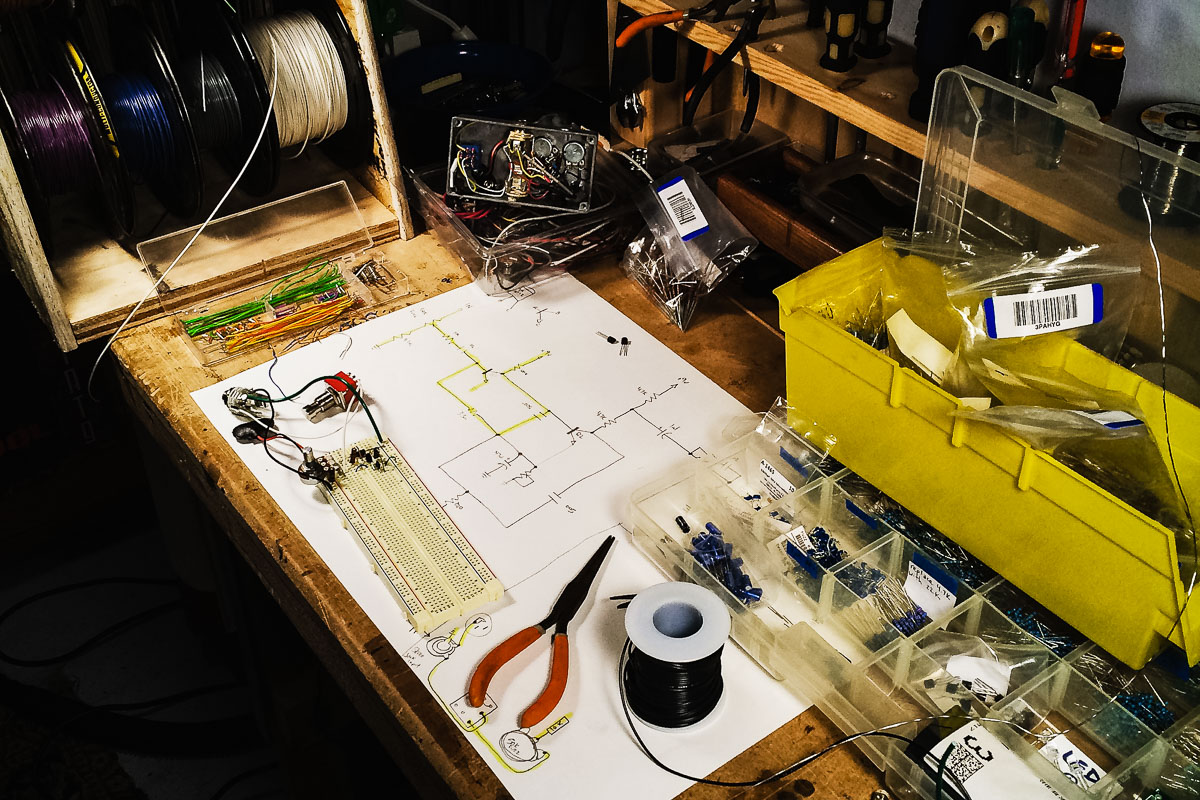 Schematics Shhematics: Trying to build something new on the breadboard.
Schematics Shhematics: Trying to build something new on the breadboard.
Lou Reed bought one too, right?
Yeah! A guitarist in his band had one, and apparently Lou was like, “Hey, what’s going on down here?” So yeah, I got an email one day from his guitar tech, Stewart Hurwood, saying that Lou was interested in purchasing a Fuzz-Stang. I was like, “Uh, okay…” — I was waiting to get Punk’d, or whatever! [laughs]
I became buds online with Stewart, because he’s a guitar tech and we talked guitar nerd stuff; and after Lou passed away, he emailed me: “Hey, we’re going through Lou’s stuff. Do you want me to put that Fuzz-Stang in a box and mail it to you?” I replied, “No, that’s cool; you can have it, Stewart.” And then, like two minutes later, I wrote him again to say, “Actually, can you send it to me? I’m sorry — I wasn’t thinking straight!” [laughs] Now it lives on my amp here in my workshop, the one that people play through when they come to pick their stuff up. If they say, “Hey, can I check out the fuzz thing?” I’ll let ‘em play through it for a while before I hit ‘em with that punch — “That used to be Lou Reed’s pedal!” [laughs]
How did the Fuzz-Stang Mark II evolve out of the Fuzz-Stang Mark I?
Being a collector-nerd of cards, comics and records, after I sold out of the 100 of the first version… I’d advertised it as a limited edition, so I didn’t just want to change the color of the LED or change the knobs and put it out again. I wanted to change it enough that I felt good about it being a distinct version. So that’s when I made the new version, which is louder, and I added an Attack knob which is kind of a gate — you can get the thing to really choke down, or make it wide open with plenty of sustain. On the first version, there’s a tiny little trim pot inside which you can use to dial that in, like the Attack knob on the current version, but it was super-sensitive. Like, the only really usable range on the trim pot would be like from 11 o’clock to 1 o’clock, so now that 11 to 1 is the full sweep of the current Attack knob.
I love the second Fuzz-Stang. The first one’s cool and everything, but it’s just the standard vintage-style set-it-and-forget-it fuzz pedal. It’s not super-versatile, in terms of tone, whereas the four-knob version is pretty awesome! When I make ‘em, I’ll plug ‘em in to test ‘em, and every now and then I’ll realize that I’ve been jamming away with it for twenty minutes! [laughs] And plenty of self-described “old, jaded musicians” have told me that they’ve been pretty inspired by it. It’s really touch-sensitive, so how you’re playing really changes the sound.
Are parts for either of the Fuzz-Stangs difficult to come by?
They’re all standard, which was another thing that I personally love. I get the whole “voodoo transistors from Russian lab” thing, where they unearth eight of them and make two pedals from them, but I did not want to fuck around with that. [laughs] The transistors used in the Sam Ash Fuzz-Stainer are silicon transistors, not germanium, and they’re still manufactured today. They’re the same exact model number; I didn’t even have to substitute a similar transistor. It’s funny — the transistors in the first Fuzz-Stang are the same exact ones as in the second one, and they’re all from the same batch. But there are people online saying all sorts of stupid shit, like, “You’ve gotta get the first one — they’re germanium transistors!” And it’s like, “No, they’re not.” [laughs]
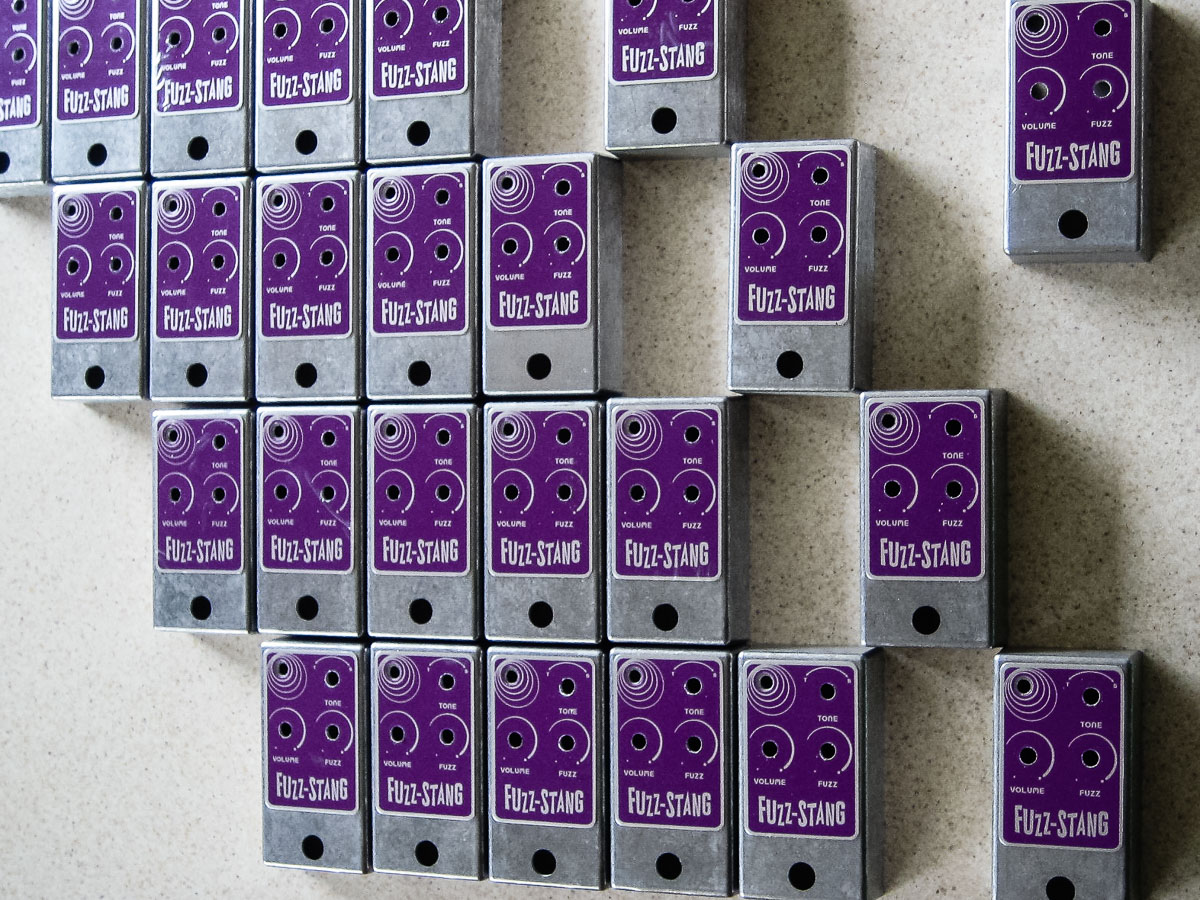 The first batch of 25 hand-drilled Fuzz-Stang enclosures.
The first batch of 25 hand-drilled Fuzz-Stang enclosures.
Jon Spencer uses a Fuzz-Stang Mark II, right?
Yes, he’s got Mark II Number One, the very first Mark II I built! One difference between the first version of the Fuzz-Stang and the second version is that the first version was hand-wired through perf board; the second version is a circuit board. I am friends with Mark Keppinger, the guy who makes Jon’s theremin, and Mark helped me with the circuit board layout. And when we were doing that, he said, “You know who would love this? Jon Spencer!”
Mark hooked us up, and we went backstage when the Blues Explosion came to town, and I told Jon I wanted to give him the pedal. He was like, “Come over here,” took me over to the merch table, and he gave me, like, nine of his albums in return! Dude, that guy is amazing; he’s so nice. He’s mentioned me in a bunch of interviews with guitar magazines, and he’s been a super-cool booster. He emailed me once out of the blue just to say, “Dude, I just ran a mellotron through the Fuzz-Stang. Sounds fucking amazing!” And that was it! [laughs]
 Ye Ole Workshop: Can you identify three LPs?
Ye Ole Workshop: Can you identify three LPs?
How about Marc Ribot? Which Fuzz-Stang does he use?
Both, actually! He emailed me and gave me feedback on the first version. He was like, “Hey, I totally dig the pedal, but I wish it was louder. I wish I could blow my speakers if I wanted to!” So that was kind of a key input for when I did the second version; I added a clean boost stage at the end of the circuit that doesn’t really affect the fuzz at all — it just makes it louder. It’s kind of stupid loud! I even include a warning on the little manual card I include with the pedal: “Be aware of your levels! Start out at one and go from there!”
Do you see yourself ever making other pedals?
I made a SuperBoost a few years ago, but that’s just kind of a separate thing. It’s a simple circuit, hand-wired. It’s not a huge seller, by any means. I think of it as an “old man” pedal; it’s not a head-turner, per se, but it is useful. A lot of people use it at the front of their signal chain, to just drive the signal through, like if they have ten or twelve pedals, or whatever. I have a little five-watt amp; I love to dime the SuperBoost and shred that little guy!
I was working on a tremolo pedal, but that was well beyond my scope of knowledge. Long story short, that’s just kind of been put aside. [laughs] I was thinking about maybe even doing a third version of the Fuzz-Stang, or tweaking the boost pedal a little bit, so it could be more than an overdrive.
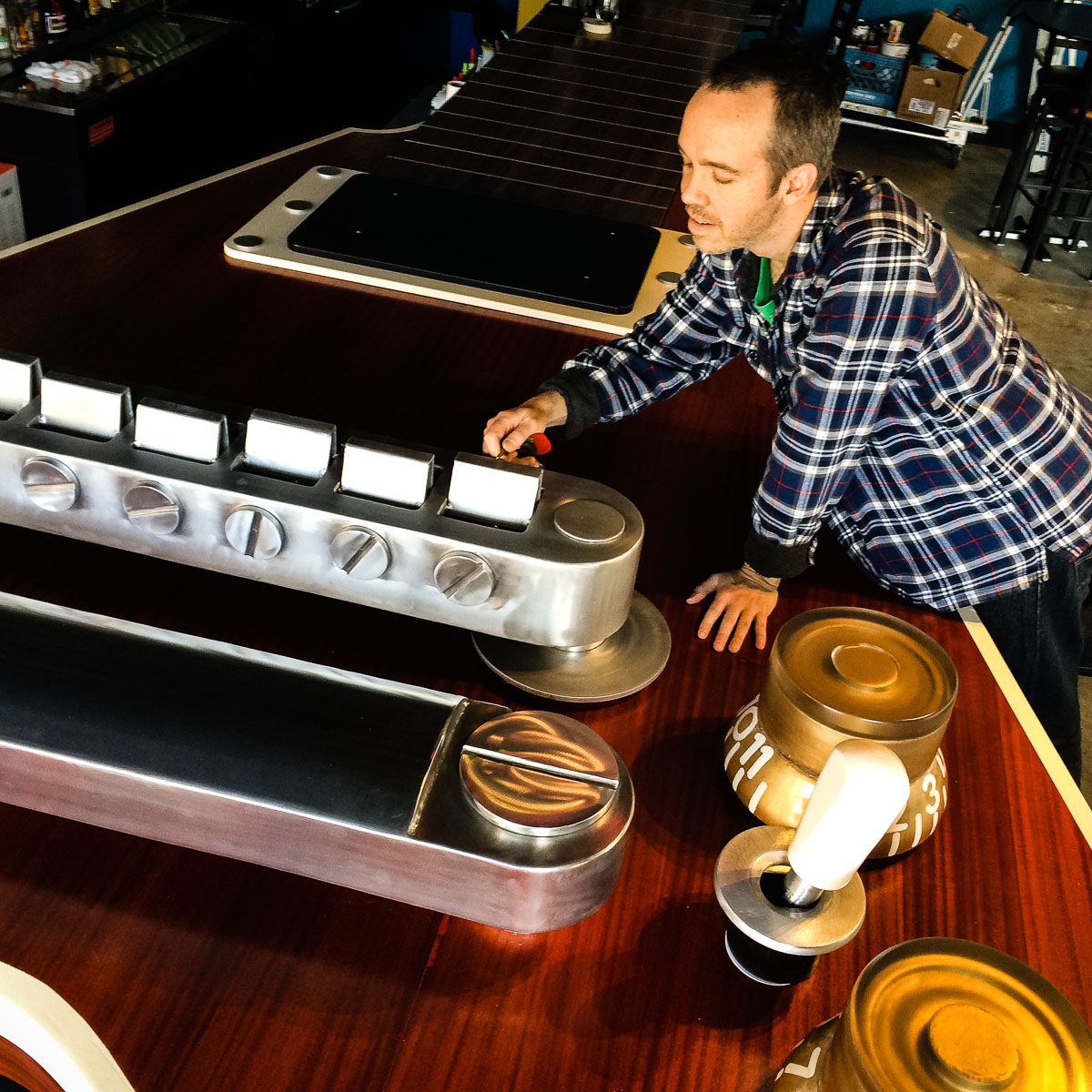 Sometimes I shrink myself in order to solve a problem.
Sometimes I shrink myself in order to solve a problem.
What kind of improvements would you put in a Fuzz-Stang Mark III?
Probably not much; it would probably just be a smaller enclosure. I might get rid of the battery. Both the first and second versions can be powered with a nine volt battery or a plug-in adapter; so I might just make it with a plug-in adapter, and lower the price.
You’ve obviously had some pretty cool musicians pick up on the Fuzz-Stang. But is there one particular guitarist out there that you would love to hear plug into it?
My gut answer is… Dweezil Zappa. I love Frank Zappa, and I’ve seen Dweezil twice. I’m always blown away by his playing; I think he would really eat up the touch-sensitive aspects of the pedal, and would find a way to incorporate it into some pretty sweet sounds. Bill Frisell texted me out of the blue once to say, “Hey, man. I’m in Colorado doing a solo show. I’m using the Fuzz-Stang, and getting some really cool Close Encounters of the Third Kind sounds out of it!” [laughs] I think Dweezil Zappa would be able to get some Close Encounters tones out of it, too. And it would be pretty neat to hear him rip some of Frank’s licks through the Fuzz-Stang!
